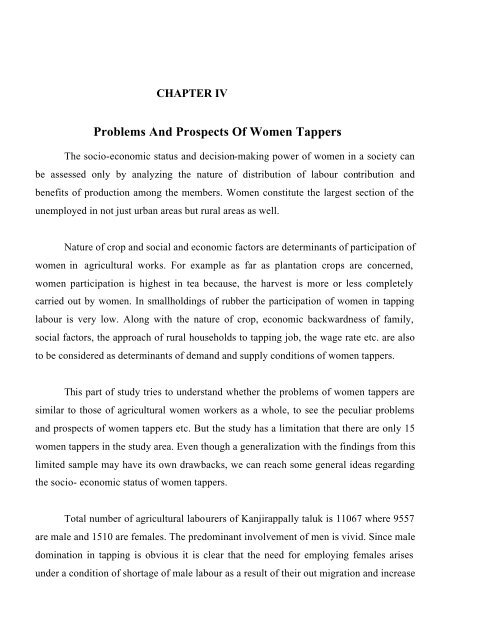socio-economic profile of rubber tappers in the small holding sector
socio-economic profile of rubber tappers in the small holding sector
socio-economic profile of rubber tappers in the small holding sector
You also want an ePaper? Increase the reach of your titles
YUMPU automatically turns print PDFs into web optimized ePapers that Google loves.
CHAPTER IV<br />
Problems And Prospects Of Women Tappers<br />
The <strong>socio</strong>-<strong>economic</strong> status and decision-mak<strong>in</strong>g power <strong>of</strong> women <strong>in</strong> a society can<br />
be assessed only by analyz<strong>in</strong>g <strong>the</strong> nature <strong>of</strong> distribution <strong>of</strong> labour contribution and<br />
benefits <strong>of</strong> production among <strong>the</strong> members. Women constitute <strong>the</strong> largest section <strong>of</strong> <strong>the</strong><br />
unemployed <strong>in</strong> not just urban areas but rural areas as well.<br />
Nature <strong>of</strong> crop and social and <strong>economic</strong> factors are determ<strong>in</strong>ants <strong>of</strong> participation <strong>of</strong><br />
women <strong>in</strong> agricultural works. For example as far as plantation crops are concerned,<br />
women participation is highest <strong>in</strong> tea because, <strong>the</strong> harvest is more or less completely<br />
carried out by women. In <strong>small</strong>hold<strong>in</strong>gs <strong>of</strong> <strong>rubber</strong> <strong>the</strong> participation <strong>of</strong> women <strong>in</strong> tapp<strong>in</strong>g<br />
labour is very low. Along with <strong>the</strong> nature <strong>of</strong> crop, <strong>economic</strong> backwardness <strong>of</strong> family,<br />
social factors, <strong>the</strong> approach <strong>of</strong> rural households to tapp<strong>in</strong>g job, <strong>the</strong> wage rate etc. are also<br />
to be considered as determ<strong>in</strong>ants <strong>of</strong> demand and supply conditions <strong>of</strong> women <strong>tappers</strong>.<br />
This part <strong>of</strong> study tries to understand whe<strong>the</strong>r <strong>the</strong> problems <strong>of</strong> women <strong>tappers</strong> are<br />
similar to those <strong>of</strong> agricultural women workers as a whole, to see <strong>the</strong> peculiar problems<br />
and prospects <strong>of</strong> women <strong>tappers</strong> etc. But <strong>the</strong> study has a limitation that <strong>the</strong>re are only 15<br />
women <strong>tappers</strong> <strong>in</strong> <strong>the</strong> study area. Even though a generalization with <strong>the</strong> f<strong>in</strong>d<strong>in</strong>gs from this<br />
limited sample may have its own drawbacks, we can reach some general ideas regard<strong>in</strong>g<br />
<strong>the</strong> <strong>socio</strong>- <strong>economic</strong> status <strong>of</strong> women <strong>tappers</strong>.<br />
Total number <strong>of</strong> agricultural labourers <strong>of</strong> Kanjirappally taluk is 11067 where 9557<br />
are male and 1510 are females. The predom<strong>in</strong>ant <strong>in</strong>volvement <strong>of</strong> men is vivid. S<strong>in</strong>ce male<br />
dom<strong>in</strong>ation <strong>in</strong> tapp<strong>in</strong>g is obvious it is clear that <strong>the</strong> need for employ<strong>in</strong>g females arises<br />
under a condition <strong>of</strong> shortage <strong>of</strong> male labour as a result <strong>of</strong> <strong>the</strong>ir out migration and <strong>in</strong>crease










